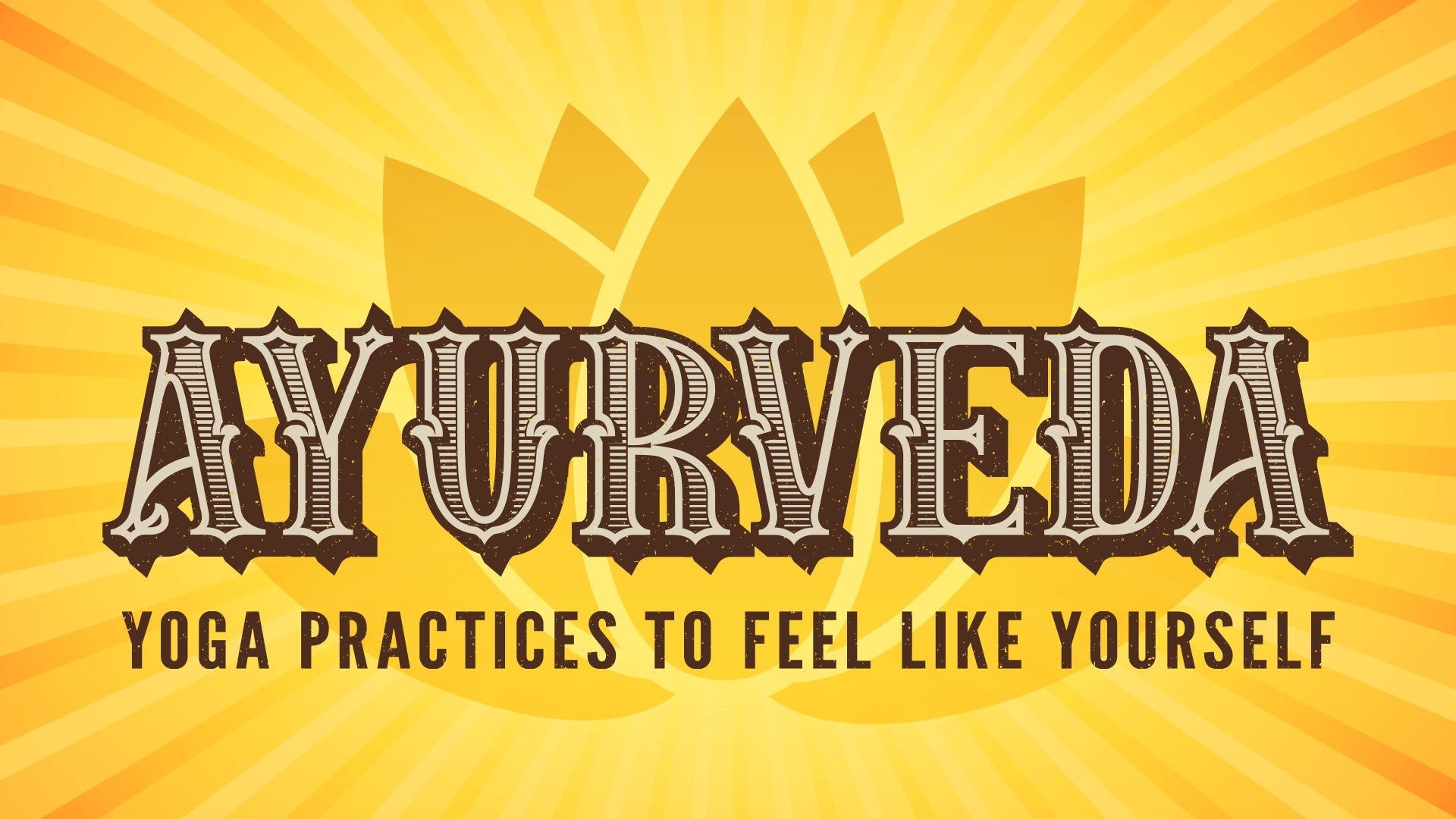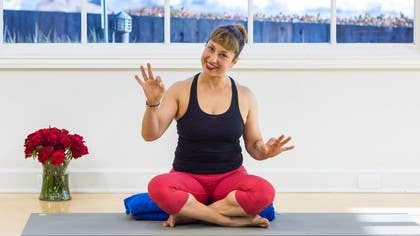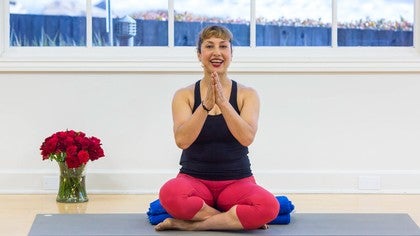Description
About This Video
Transcript
Read Full Transcript
Chapter 1
Kapalabhati Breath
Namaste, I'm Ali and this is going to be your tutorial for your morning pranayama routine. We're going to really break down each technique, go through it, try them out together and see what happens. Before we get started though, I do want to mention it's best to do this on an empty stomach. Before you've eaten, it's best to try to go to the bathroom before you start and ladies, if you're pregnant or you're on the first day or so of your cycle, this is not the routine for you. Stay with some of the quieter practices.
Another reason not to do this would be if you've got, if you suffer with migraines or you've got headaches or something going on with the eyes, it's not recommended to do some of these more heating breath practices. What's so good about this routine though, is that in the morning it really gets your energy going. In Ayurveda we have something called Agni, which is our digestive fire and we want to get that going. We want to get that going so that when we start to eat, we take in nutrition, our body can process it and get all the nutrients, so this particular routine will definitely get the Agni going if you're waking up and you're feeling a little sluggish, this will get you going in the morning. All right, so let's get started.
We're going to start off with Kapalabhati. Kapalabhati means skull shining breath, so it's really about getting any energy that feels stuck at the base of the spine traveling upward to polish the skull and it's great for clearing out your thoughts, getting your head straight for the day and clear thinking. So with Kapalabhati, it's not a super deep breath. We usually start on like a halfway inhale and the emphasis is going to be on the exhalation. The inhale just happens naturally.
You don't even think about the inhale, just concentrate, focus on exhale, exhale, exhale and it's a rhythmic breath. Now these practices are incredibly powerful, so if it feels like you're starting to get a little lightheaded or dizzy or just not feeling so good, then stop, stop, listen to your body please and take care of yourself. So the emphasis is on the exhalation, the inhale will just happen naturally and it's a rhythmic quick breath, quick breath. So you're going to inhale deeply, you'll exhale deeply and then inhale halfway and it just looks like this, so my spine is remaining tall, thigh bones released, I've got a good strong seat here and just the belly is dancing its way back towards the spine and it brings all that energy upward. So now maybe let's try it together.
You can keep your eyes open or let your eyes float closed and take a breath in, breathe it out, we're going to go for 10 rounds, so inhale halfway and go, exhale, exhale, exhale, exhale, exhale, exhale, exhale, exhale, exhale, exhale, exhale, eight, nine, ten, breathe in and breathe out. And then just see how you feel, automatically it starts to wake you up a little bit.
Chapter 2
Bhramari Breath
Our second technique is one of my favorites actually, it's called brahmari breath and brahmari means bumblebee because the sound of this breath is a humming, a soft humming that almost sounds like a bumblebee. This breath is very good if you've got thyroid stuff going on, so I did mention that this morning pranayama is for all three dosha's but especially good for kappa dosha. So if you know that you've got a lot of kappa or it's kappa time of day, kappa time of day is from 6 to 10 a.m. in the morning and you're trying to get out the door with some energy, this would be a great routine for you.
So with the brahmari you're going to inhale and it doesn't have to be a huge breath in, just a normal gentle breath in and then keeping the lips together, a soft hum on the breath out and you get almost like this little tickle in the front of your lips. So I'll just show you a couple and then we'll try it together. So nice just to get a little bit of that energy vibrating in the throat. So take a breath in, we'll try it together and then breathing out and that gentle hum doesn't have to be loud, just a little vibration in the throat and then again breathing in and breathing out with your hum, no forcing, just real gentle and then just sit for a moment and feel the effects. I find this one very calming, very soothing.
Chapter 3
Bhastrika Breath
And so before our next technique, this is a really good place if you're feeling like your legs are starting to get a little sluggish, shake your legs out and then you can re-cross them in the opposite direction, just getting a little balance going in your seat or if you prefer to stay seated the whole time then you'll stay seated the whole time. Our next practice is called bastrika and this one is actually the most heating of all of them. So we don't do this one for quite as long and this one again is to get the agni going, to get the energy working and even to get the muscles of the abdomen to really start to work so that we feel that strength of the core throughout our day. Just getting this going in the morning is such a powerful practice. So some of you might have done breath of fire if you've taken a kundalini class, you definitely know about breath of fire.
Bastrika is similar to breath of fire. The difference is that it's slower and deeper, slower and deeper. So I'll show you a couple of times and then we'll try it together. I'm taking a full breath in. So when I'm doing this, not only do I feel this in my belly but I'm actually feeling this in the back of my waist as well.
Really try to work the whole circumference of the waist so you get like this cinching feeling and then this big wide spreading feeling. So let's try just a couple rounds together and again, if this feels too heating for you, if it feels like too much, slow down just a couple rounds just to get the feel for it and you'll build up. All right, so take a full breath in. Let's go for maybe three rounds of it. Breathe in, breathe in and strong exhalation.
Deep inhale, strong exhalation, deep inhale, strong exhalation and let it go. And then just again pausing, especially after that one, just to really feel the effects of it. It doesn't need to be a long practice, just focused.
Chapter 4
Nadi Shodhana
Our next technique is called Nadi Shodna, but for the purposes of this particular practice, we're going to take it a little faster. You might have done it before, it's alternate nostril breathing.
Nadi Shodna is designed to balance our nadis. So what are those? Nadis are the energy channels in the body. Our main energy channel is called the Shoshumna Nadi and it runs right up the center of the body. And then on either side of it are the Ida and the Pingala, so the Ida is related to the moon and it's cooling and the Pingala is related to the sun and it's heating.
And so the Ida and the Pingala, they crisscross like this, all the way up the Shoshumna Nadi and every time that they cross, that is the location of a chakra. So what we're seeking to do with Nadi Shodna is balance out Ida and Pingala. Because this is a morning practice, we want it to be a little bit more on the heating side. So we're going to actually start breathing in through the right nostril, which is again associated with the Pingala, it's a little bit more heating, it's a little bit more solar energy. So you'll take your hand and fold in your index finger and your middle finger and then what you have left out is your thumb and your ring finger and your pinky finger.
And this will be your right hand, make sure you're using your right hand. This mudra is called Vishnu mudra, reminder that Vishnu is part of the Hindu triumvirate of gods and he is known as the sustainer god. So it's nice to bring in that element when we're working with breath work, that imagery of being sustained by our breath. So you'll hover the hand in front of your nose, again I'll show you a couple rounds and then we'll try it together. You'll hover your hand in front of your nose and I'm not pushing hard on my nostrils, it's a gentle light touch here.
And I'm going to breathe in through both nostrils, breathe out through both nostrils and then use the ring finger to close off the left and inhale right, close off with my thumb, with my ring finger, exhale left. Inhale left, close off with the ring finger and exhale right. One more time, inhale right and exhale left and inhale left and exhale right. So let's try it together, bring your right hand into your Vishnu mudra, folding in the index finger and middle finger, other three fingers are out, hover the hand in front of your nose, take a deep breath in through both nostrils, breathe out through both nostrils and then using your ring finger, close off your left nostril, inhale right, exhale left, inhale left, exhale right, again inhale right, exhale left, inhale left, exhale right. Last time, inhale right and exhale left and inhale left and exhale right and then let it go and again just pause and feel the effects, just feel it, any little shifts.
You might notice that your mind already feels a bit clearer.
Chapter 5
Uddiyana Bandha
And so our last technique, what we're going to close with, this is really like the clincher for the Agni, for the digestive fire. It's called Uriyana Bandha and Uriyana means the flying up and Bandha means like lock. So this is the flying up lock that happens right in the guts and it's a little tricky if it's something that you've never done before. So a good way to learn it is to start on your back with it.
So I'm going to show you, we're going to talk it through on your back. So you can slide, if you're sitting on something, just slide it off to the side and then come to lie down on your back with your knees bent and the soles of your feet on the ground. And you'll let your hands rest down by your sides. So I can talk you through it and then we'll try it together. I'm pushing down into my feet and I'm going to lift my hips up and come into a bridge pose and then I take my arms up over my head and let them fall to the ground behind me but my hips stay lifted.
I'm taking a full breath in, you can see my belly expanding and then I'm going to breathe everything out. And when I get to the bottom, I'm going to hold the breath out and keeping the breath held out, I'll lower my tailbone down so it'll look like this. And all this energy just comes flooding in. So if it was a little unclear, what's happening is that there's this vacuum-like hold that's created in the belly and you can feel all the muscles of the belly really stretching and holding. It's important to hold the breath out as strongly as possible and try to get as empty as you possibly can before you lower down and you'll feel this vacuuming sort of feeling.
I feel it actually all the way up towards my throat but all the breath needs to be completely out in order to get that suction effect going. So we can try it together. Take your arms up over your head, push down into your feet, lift your hips up. Really using the legs here, take a full breath in and then everything out get as empty as you possibly can, empty, empty, empty, empty, empty, empty, empty, empty. And then hold the breath out, hold it out, hold it out and gently, slowly lower the hips down and you don't need to press the lower back down, just let your tailbone hang there.
There should be a little bit of a natural curve in your spine. You'll feel that vacuuming suction feeling and then when you need to, breathe in and a nice cleansing breath out, let it go. And in the routine we're only going to do it two times. So hopefully you got a sense of what that feels like but I'd like to do it now sitting up. So you can grab your blankets and really trying to set yourself up in a good seat is so important for pranayama so that the spine can be long and that's more so that energy can flow well and not be obstructed by slouching or sitting a little bit more strongly into one hip or the other.
So make sure that once you come back into your seat, you set up a good seat and again, I'll do it a couple of times and then I'll talk you through it and we'll do it together. So I'm taking a full breath in, breathe everything out, get empty, empty. And breathe out, a couple little pointers here. If you noticed, I did slightly bring the chin back towards the chest and what happens then is that it engages what's called Jalandharabhandha and Jalandharabhandha is our chin lock. What that does is it's almost like you're sealing things off both at the bottom and at the top and that circulates energy right there around the heart, around the belly, stimulating all those internal organs.
It also brings some energy into the throat which will stimulate thyroid and it also gets our fifth chakra going which is our sense of truth. Another quick mention is pressing down into the thighs, I'm straightening my arms out and the shoulders might come up slightly, that's okay. Letting the shoulders come up and the belly just right back in towards the lower back, feel up the back, even clearing out the kidneys a little bit, it gives the kidneys a little bit of stimulation with this one. So it's a really wonderful practice to work on. But again, doesn't have to be a lot, two rounds is a great idea.
The last tip that I'm going to leave you with is try not to hold it longer than you need to, okay? So the minute that you start to feel like it's a little bit of a strain, let it go, let it go, breathe in and just release and we'll pause between rounds, we're going to do it twice. Quick mention, I'm going to do this with you, I'm not going to straighten the arms, I'm going to take my hands back on my thighs a little bit just so you can see what's happening with my belly, okay? But in this one, as I mentioned, the hands are pressing into the thighs, the arms are straight, okay? So let's try it together, take a full breath in.
Breathe everything out, get as empty as you possibly can, keep squeezing out every last bit of air and then pushing down, draw the belly back, holding the breath out, lifting the navel. And then when you need to, release the locks, take a breath in and a breath out. And let's try it one more time, last time, breathe in deeply, breathe everything out, empty empty, push the air out, push it out and in the emptiness, retain the emptiness, big lift of the navel, pull the belly back into the spine, press into the hands, work to straighten the arms, shoulders might come up a little, chin dips back, there you are. And then breathe in and breathe everything out. And that's our last technique, but I think it's nice when you're done, instead of just jumping up and running off to your day, have a moment just to sit and be with your breath.
I like to take my hands and take them into Janamudra, so the index finger comes to the first knuckle of the thumb, palms can be upright on top of the thighs, the index finger represents the ego and the thumb represents cosmic consciousness, the whole. So just the ego is bowing to cosmic consciousness and you can place the hands upright on the thighs. And then one other thing that I want to mention, you know, we always see those ancient pictures of all the great yogis and buddhas sitting with the hands resting on the inner thighs, and there's actually a reason for that. The nadis that I was mentioning, there is a nadi, it's called the gupta, and it runs from the inner arch of the foot all the way up through the inseam of the thigh and into the base of the pelvis. So the idea is that when we place our hands right there, we're pressing into the gupta and stimulating that energy to start rising from the soles of the feet and up into the base of the spine, and then we just keep carrying it up, up, up with all of these practices.
So have a moment to just sit, watch your breath, your eyes can close. And then if you just want to try one last thing, I teach this often in my classes, take a breath in and hold your breath, and just hold it, just hold it. And at some point, even though your mind is saying hold the breath, you won't be able to, we'll start again. And so it's pretty amazing to think about that we're always being sustained, even when we're trying to shut down life, life keeps happening. So with that, have a beautiful day, I hope you have a beautiful life, thank you for sharing your practice, namaste.






You need to be a subscriber to post a comment.
Please Log In or Create an Account to start your free trial.